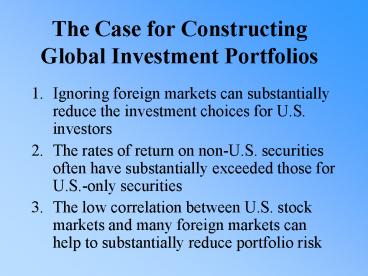The Case for Constructing Global Investment Portfolios - PowerPoint PPT Presentation
1 / 21
Title:
The Case for Constructing Global Investment Portfolios
Description:
The Case for Constructing Global Investment Portfolios. Ignoring ... Issued in the United States by transfer agent on behalf of a foreign firm. Higher expenses ... – PowerPoint PPT presentation
Number of Views:50
Avg rating:3.0/5.0
Title: The Case for Constructing Global Investment Portfolios
1
The Case for Constructing Global Investment
Portfolios
- Ignoring foreign markets can substantially reduce
the investment choices for U.S. investors - The rates of return on non-U.S. securities often
have substantially exceeded those for U.S.-only
securities - The low correlation between U.S. stock markets
and many foreign markets can help to
substantially reduce portfolio risk
2
Relative Size of U.S. Financial Markets
- The share of the U.S. in world capital markets
has dropped from about 65 percent of the total in
1969 to about 48 percent in 2000 - The growing importance of foreign securities in
world capital markets is likely to continue
3
The Case for Global Investments
- Rates of return available on non-U.S. securities
often exceed U.S. Securities due to higher
growth rates in foreign countries, especially the
emerging markets
4
The Case for Global Investments
- Diversification with foreign securities can
- help reduce portfolio risk because foreign
- markets have low correlation with U.S. capital
- markets
5
Summary on Global Investing
- Relatively high rates of return combined with low
correlation coefficients indicate that adding
foreign stocks and bonds to a U.S. portfolio will
reduce risk and may increase its average return
6
International Bond Investing
- Bond identification characteristics
- Country of origin
- Location of primary trading market
- Home country of the major buyers
- Currency of the security denomination
- Eurobond
- An international bond denominated in a currency
not native to the country where it is issued
7
International Bond Investing
- Yankee bonds
- Sold in the United States and denominated is U.S.
dollars, but issued by foreign corporations or
governments - Eliminates exchange risk to U.S. investors
- International domestic bonds
- Sold by issuer within its own country in that
countrys currency
8
Equity Investments
- Returns are not contractual and may be better or
worse than on a bond
9
Equity Investments
- Common Stock
- Represents ownership of a firm
- Investors return tied to performance of the
company and may result in loss or gain
10
Acquiring Foreign Equities
- 1. Purchase of American Depository Receipts
(ADRs) - 2. Purchase of American shares
- 3. Direct purchase of foreign shares listed on a
U.S. or foreign stock exchange - 4. Purchase of international mutual funds
11
American Depository Receipts (ADRs)
- Easiest way to directly acquire foreign shares
- Certificates of ownership issued by a U.S. bank
that represents indirect ownership of a certain
number of shares of a specific foreign firm on
deposit in a U.S. bank in the firms home country - Buy and sell in U.S. dollars
- Dividends in U.S. dollars
- May represent multiple shares
- Listed on U.S. exchanges
- Very popular
12
Purchase or Sale of American shares
- Issued in the United States by transfer agent on
behalf of a foreign firm - Higher expenses
- Limited availability
13
Direct Purchase of Foreign Shares
- Direct investment in foreign equity markets-
difficult and complicated due to administrative,
information, taxation, and market efficiency
problems - Purchase foreign stocks listed on a U.S. exchange
limited choice
14
Returns of Stocks, Bonds, and T-Bills
- Ibbotson and Sinquefield (IS) examined nominal
and real rates of return for seven major classes
of assets in the United States - 1. Large-company common stocks
- 2. Small-capitalization common stocks
- 3. Long-term U.S. government bonds
- 4. Long-term corporate bonds
- 5. Intermediate-term U.S. Treasury bills
- 6. U.S. Treasury bills
- 7. Consumer goods (inflation)
15
Derived Series Historical Highlights (1926 -
2001)
- I S computed geometric and arithmetic mean
rates of return - They derived four return premiums
- 1. Risk premium
- 2. Small-stock premium
- 3. Horizon premium
- 4. Default premium
16
Annual Total Returns,1926-2001
Average Standard Return
Deviation Distribution Arith Geom
Small-company stocks 17.3 12.5
33.2 Large-companystocks 12.7
10.7 20.2 Long-termcorporate bonds 6.1
5.8 8.6 Long-termgovernment
5.7 5.3 9.4 Intermediate-termgovern
ment 5.5 5.3 5.7 U.S.
Treasurybills 3.9
3.8 3.2 Inflation 3.1
3.1 4.4
17
Returns of Stocks, Bonds, and T-Bills
- Returns and risk increase together
- Rates of return are generally consistent with the
uncertainty of returns
18
The Effect of Taxes and Inflation on Investment
Returns, 1926 - 1998
Figure 2.6
Before Taxes
After Taxes and Inflation
After Taxes
19
World Portfolio Performance
- Ibbotson, Siegel, and Love examined the
performance of assets around the world - Asset return and risk relationship is confirmed
- Coefficients of variation range widely, showing
benefits of global diversification - Correlations between asset returns vary by global
regions
20
Real Estate
- Returns are difficult to derive due to lack of
consistent data - Residential shows lower risk and return than
commercial real estate - During some short time periods REITs have shown
higher returns than stock with lower risk
measures - Long term returns for real estate are lower than
stocks, and have lower risk
21
Real Estate
- Negative correlation between residential and farm
real estate and stocks - Low positive correlation between commercial real
estate and stocks - Potential for diversification































